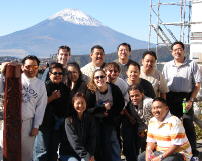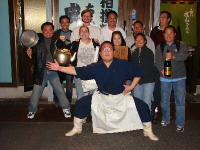 We got off the boat and entered Asakusa. We would save touring the city for another time. Today our intent was to visit Sensoji Temple and do some shopping for "omiyage" at Nakamise Dori. We took a quick picture before we left the dock area with the famous black and gold Asahi Beer building in the background.
We got off the boat and entered Asakusa. We would save touring the city for another time. Today our intent was to visit Sensoji Temple and do some shopping for "omiyage" at Nakamise Dori. We took a quick picture before we left the dock area with the famous black and gold Asahi Beer building in the background. 
Nakamise was originally formed around 1685 when the 12 subsidiary temples belonging to the Senso-ji Temple that lined both sides of the street were permitted to put out souvenir stalls in front of local houses in exchange for a promise by local residents to keep the area clean. It began to be called Nakamise (“inner shopping street”) because it is located between the shops of Kannondo-mae and the Asakusa-Hirokoji path. http://www.asakusa-nakamise.jp/e-index.html

 Apparently the smoke from the burning incense is supposed to help purify and heal you. People use their hands to try and focus the smoke on any part of their body that they would like good health. Here you see Richard and Matt doing their best to direct the smoke toward themselves. Whenever I look at this picture I imagine that Richard is preparing to grab the sides of the incense burner with his bare forearms like David Carradine as Kwai Chang Caine in the television show Kung Fu! Check out David Carradine on IMDB through this link. http://www.imdb.com/name/nm0001016/
Apparently the smoke from the burning incense is supposed to help purify and heal you. People use their hands to try and focus the smoke on any part of their body that they would like good health. Here you see Richard and Matt doing their best to direct the smoke toward themselves. Whenever I look at this picture I imagine that Richard is preparing to grab the sides of the incense burner with his bare forearms like David Carradine as Kwai Chang Caine in the television show Kung Fu! Check out David Carradine on IMDB through this link. http://www.imdb.com/name/nm0001016/ Another purification ritual at most temples involve washing your hands and mouth before entering. Here you see most of us partaking in the this ritual before entering the temple.
Another purification ritual at most temples involve washing your hands and mouth before entering. Here you see most of us partaking in the this ritual before entering the temple.We finally enter Sensoji Temple and make an offering. Sensoji is Tokyo's oldest and most popular temple. According to legend, in 628 two brothers fishing in the nearby Sumida River netted a tiny golden statue of Kannon, the Buddhist goddess of mercy and happiness. The chief of their village recognized the sanctity of the statue and enshrined it by remaking his own house into a small temple so that the villagers could worship the Kannon. The blessings of the Kannon gradually received a high reputation throughout Japan, and people near and far flocked to Asakusa to venerate the statue. I understand that the statue is still housed here but is never shown to the public. Sensoji Temple burned down during a 1945 bombing raid and the present structure was rebuilt with donations by the Japanese people.




No comments:
Post a Comment